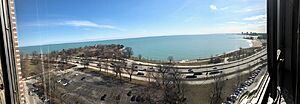Hyde Park, Chicago facts for kids
Quick facts for kids
Hyde Park
|
|
|---|---|
| Community Area 41 – Hyde Park | |
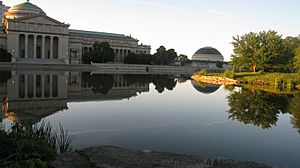
Hyde Park in Chicago
|
|
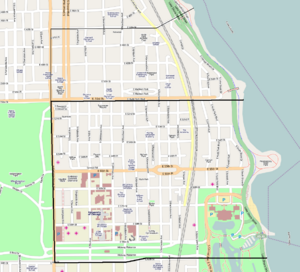
The official Hyde Park community area (bold black) and the unofficial Hyde Park-Kenwood neighborhood extending into the official Kenwood community area (thin black).
|
|

Location of Hyde Park in Chicago
|
|
| Country | United States |
| State | Illinois |
| County | Cook |
| City | Chicago |
| Neighborhoods |
List
Hyde Park
East Hyde Park |
| Area | |
| • Total | 1.65 sq mi (4.27 km2) |
| Population
(2020)
|
|
| • Total | 29,456 |
| • Density | 17,867/sq mi (6,898/km2) |
| Demographics (2020) | |
| • White | 47.0% |
| • Black | 24.4% |
| • Asian | 14.2% |
| • Hispanic | 7.5% |
| • Other | 6.9% |
| Educational Attainment 2018 | |
| • High School Diploma or Higher | 96.77% |
| • Bachelor's Degree or Higher | 75.00% |
| Time zone | UTC-6 (CST) |
| • Summer (DST) | UTC-5 (CDT) |
| ZIP codes |
parts of 60615 and 60637
|
| Median household income 2020 | $52,423 |
| Source: U.S. Census, Record Information Services | |
Hyde Park is a cool neighborhood on the South Side of Chicago, Illinois. It's right by Lake Michigan, about 7 miles south of downtown Chicago. It's one of Chicago's 77 official community areas.
The borders of Hyde Park can be a bit tricky! Officially, it runs from 51st Street in the north to the Midway Plaisance in the south. Washington Park is to its west, and Lake Michigan is to its east. Sometimes, people also include a part north of 51st Street, up to 47th Street, as part of Hyde Park. This area is actually the southern part of the Kenwood community area. Because of this, Hyde Park and South Kenwood are often called "Hyde Park-Kenwood."
Hyde Park is home to the famous University of Chicago and several important religious schools. You can also find the amazing Griffin Museum of Science and Industry here. Two very important historical sites are also in the neighborhood: Chicago Pile-1, which was the world's first artificial nuclear reactor, and Robie House, a famous building designed by Frank Lloyd Wright. Hyde Park also became well-known because U.S. President Barack Obama lived here for many years before he became president. The Barack Obama Presidential Center is being built nearby in Jackson Park.
Contents
History of Hyde Park
How Hyde Park Started
In 1853, a man named Paul Cornell, who bought and sold land, bought about 300 acres of land by Lake Michigan. He wanted to create a nice place for Chicago business people and their families to live. He named it after a place in New York. The area was perfect because it was rural, had cooler summers and warmer winters thanks to the lake, and was close to the Illinois Central Railroad. Paul Cornell even arranged for a train station at 53rd Street. Soon, Hyde Park became a popular getaway for wealthy Chicagoans who wanted to escape the busy city.
In 1857, a fancy hotel called the Hyde Park House was built near the 53rd Street train station. It was a central spot for social events in Hyde Park for 20 years. Many important guests stayed there, including Mary Todd Lincoln, the wife of President Abraham Lincoln, who lived there with her children in 1865. The Hyde Park House burned down in 1879. Later, the Sisson Hotel was built on the same spot in 1918, which is now a condominium building called the Hampton House.
In 1861, Hyde Park became its own independent town called Hyde Park Township. It covered a large area that is now most of Chicago's South Side. Hyde Park Township stayed independent until 1889, when it became part of the city of Chicago. After that, the name "Hyde Park" was used for the smaller, original area around 51st and 55th streets near the lake. The local newspaper, the Hyde Park Herald, started in 1882 and is still published every week!
Growing and Becoming Famous

In 1891, just two years after Hyde Park joined Chicago, the University of Chicago was founded in the neighborhood. This happened thanks to money from John D. Rockefeller and the leadership of William Rainey Harper.
In 1893, Hyde Park hosted the World's Columbian Exposition, a huge world's fair celebrating 400 years since Christopher Columbus arrived in the Americas. This fair made Hyde Park famous and brought many new people and buildings to the area, making it more like a city. Most of the fair's buildings were temporary, but one important one is still standing: the Palace of Fine Arts, which is now the Museum of Science and Industry.
In the early 1900s, many fancy hotels were built in Hyde Park, especially along the lake. Hyde Park became a popular resort spot in Chicago. However, during the Great Depression, most of these hotels closed. They were later turned into apartment and condominium buildings, many of which are still used today.
Changes and Growth
For a long time, Hyde Park was mostly a white neighborhood. But after 1948, when a court ruling made it illegal to prevent people of different races from living in certain areas, African Americans began moving into Hyde Park. The neighborhood slowly became a place where people of many races lived together.
In the 1950s and 1960s, the University of Chicago helped create a big plan to improve the neighborhood. This plan helped to update older buildings and create new spaces. As a result, Hyde Park became a diverse, middle-class neighborhood, which was a positive outcome for the community.
Parts of Hyde Park
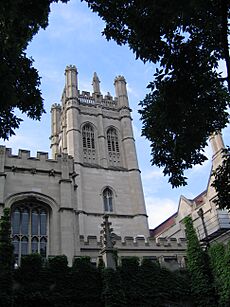
The University of Chicago
The main campus of the University of Chicago is mostly in the southwestern part of Hyde Park. This includes the medical school, the hospital, and many historic buildings. The university also owns other properties around Hyde Park, like the University of Chicago Laboratory Schools and International House. Because the university is so close, many students and teachers live in the blocks right next to the campus.
East Hyde Park
The area of Hyde Park east of the train tracks is called East Hyde Park. This part of the neighborhood is closest to Lake Michigan and has many tall condominium buildings, some of which used to be old hotels. This is different from the rest of Hyde Park, where most homes are three-story apartment buildings or single-family houses.
South Kenwood
Even though the area between 47th Street and 51st Street is officially part of the Kenwood community, many people consider it part of Hyde Park. This is because the two areas share a similar culture and history. Unlike Hyde Park, which has many apartment buildings, South Kenwood has many large, beautiful mansions. These were built for wealthy Chicagoans in the late 1800s and early 1900s. Some famous people, like former U.S. President Barack Obama, live or have lived in South Kenwood.
People in Hyde Park
| Historical population | |||
|---|---|---|---|
| Census | Pop. | %± | |
| 1930 | 48,017 | — | |
| 1940 | 50,550 | 5.3% | |
| 1950 | 55,206 | 9.2% | |
| 1960 | 45,577 | −17.4% | |
| 1970 | 33,531 | −26.4% | |
| 1980 | 31,198 | −7.0% | |
| 1990 | 28,630 | −8.2% | |
| 2000 | 29,920 | 4.5% | |
| 2010 | 25,681 | −14.2% | |
| 2020 | 29,456 | 14.7% | |
Diversity in Hyde Park

Hyde Park is a very diverse neighborhood, meaning people from many different backgrounds live there. According to the 2020 U.S. census, the residents are about 45.6% white, 26.7% Black, 14.6% Asian, and 7.2% Hispanic.
Because of its location in the middle of Chicago's mostly African-American South Side, and its large population of successful Black residents, Hyde Park is an important cultural and political center for Chicago's Black community. Many important African-American politicians from Chicago live or have lived in Hyde Park. These include former Chicago mayor Harold Washington, who was the city's first Black mayor, and former U.S. Senator Carol Moseley Braun, who was the first Black female U.S. senator. Former U.S. President Barack Obama also lived here, as does Toni Preckwinkle, who leads the Cook County Board of Commissioners.
Famous Places in Hyde Park

Many places in Hyde Park are listed on the National Register of Historic Places. This means they are important historical sites. Some of these include the Chicago Beach Apartments, the Arthur H. Compton House, and the Robie House. The site of Chicago Pile-1, the world's first nuclear reactor, is also here. You can also find the German submarine U-505 at the Museum of Science and Industry.
The Hyde Park-Kenwood Historic District and the Jackson Park Historic Landscape District and Midway Plaisance are also partly located in Hyde Park.
Parks to Explore
Promontory Point
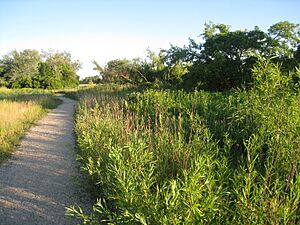
Promontory Point is a man-made piece of land that sticks out into Lake Michigan at 55th Street. It offers amazing views of the Chicago skyline. It's a great spot for picnics, sunbathing, and swimming.
Jackson Park
The northern part of Jackson Park is in the southeastern corner of Hyde Park. Jackson Park has lagoons and an island in the middle called the Wooded Island, where you can find a small Japanese garden. It's home to beavers and many different kinds of birds. The Midway Plaisance, a wide street between 59th and 60th streets, connects Jackson Park to Washington Park.
Jackson Park has been chosen as the location for the future Obama Presidential Center.
Shopping and Dining
The main shopping areas in Hyde Park are on 53rd, 55th, and 57th streets.
53rd Street
53rd Street is the oldest shopping area in Hyde Park. It has many small businesses and restaurants with different kinds of food. Harper Court, a shopping center for small businesses, is just north of 53rd Street. A farmers' market is held there in the summer.
55th Street
The part of 55th Street near the lake has many restaurants serving Thai, Japanese, and Korean food. West of the train tracks, you'll find the Hyde Park Shopping Center.
57th Street
57th Street is known for its independent bookstores. It also has restaurants, small grocery stores, hair salons, and dry cleaners. Every year on the first weekend in June, the famous 57th Street Art Fair takes place on 57th Street.
Museums to Visit
- DuSable Museum of African American History (just outside Hyde Park in Washington Park)
- Hyde Park Art Center
- Museum of Science and Industry
- Institute for the Study of Ancient Cultures – an archaeology museum at the University of Chicago.
- Smart Museum of Art – an art museum at the University of Chicago.
Schools and Universities
- Catholic Theological Union – a school for religious studies.
- Chicago Theological Seminary – another religious school.
- Lutheran School of Theology at Chicago – a seminary for Lutheran students.
- McCormick Theological Seminary – a seminary for Presbyterian students.
- University of Chicago – a private research university.
- University of Chicago Laboratory Schools – a private school for students from nursery to 12th grade, founded by John Dewey.
Churches and Other Places of Worship
- Congregation Rodfei Zedek
- The First Baptist Church of Chicago
- First Unitarian Church of Chicago
- The Hyde Park Chapel of the Church of Jesus Christ of Latter-day Saints
- The Hyde Park Seventh-day Adventist Church
- Hyde Park Union Church
- KAM Isaiah Israel
- Rockefeller Chapel
- St. Paul & the Redeemer Episcopal Church
- St. Thomas Church and Convent
- 57th Street Meeting of Friends (a Quaker meeting house)
Getting Around Hyde Park
You can easily get to Hyde Park by car using Lake Shore Drive, which runs along the east side of the neighborhood. The Dan Ryan Expressway and Chicago Skyway are also close by.
For public transportation, Hyde Park has many options. There are eleven Chicago Transit Authority (CTA) bus lines, the Metra, which is Chicago's commuter train system, and the South Shore Line, a train that goes between Chicago and South Bend, Indiana. The Metra and South Shore Line use the old Illinois Central Railroad tracks near Lake Michigan.
The Metra Electric train has three stations in Hyde Park: 51st/53rd St./Hyde Park, 55th-56th-57th St., and 59th St./University of Chicago. These trains, along with the CTA's #6 Jackson Park Express bus, offer fast service to downtown Chicago. Other buses like the #2 Hyde Park Express and #28 Stony Island also provide quick service during busy times.
The #15 Jeffrey Local bus travels through Hyde Park, connecting it to areas south and to Chicago's "L" train system (the Red and Green Lines). The #55 Garfield bus goes east-west through the neighborhood, also connecting to the Red and Green Lines and eventually to Chicago's Midway Airport.
The CTA also runs three bus routes with the University of Chicago: #171 University of Chicago/Hyde Park, #172 University of Chicago/Kenwood, and #192 University of Chicago Hospitals Express.
Famous People from Hyde Park
- Gertrude Abercrombie – painter
- Muhammad Ali – boxer
- Quentin Young – doctor
- Bill Ayers – educator and activist
- Saul Bellow – writer, Nobel Prize winner
- Lee Botts – environmentalist
- Chesa Boudin – District Attorney of San Francisco
- Carol Moseley Braun – U.S. Senator from Illinois
- Oscar Brown Jr. – singer, songwriter, and activist
- Paul Butterfield – blues musician
- Subrahmanyan Chandrasekhar – astrophysicist, Nobel Prize winner
- James W. Cronin – physicist, Nobel Prize winner
- Clarence Darrow – lawyer
- Barbara Flynn Currie, former Illinois House of Representatives Majority Leader
- Leon Despres – civil rights activist
- William Dodd – U.S. Ambassador to Germany
- Bernardine Dohrn – lawyer and activist
- Paul Douglas – U.S. Senator from Illinois
- Arne Duncan – U.S. Secretary of Education
- Amelia Earhart – famous aviator (attended high school here)
- Kurt Elling – jazz musician
- Enrico Fermi – physicist, Nobel Prize winner
- Marshall Field – founder of Marshall Field's stores
- Susan Fiske – social psychologist
- Milton Friedman – economist, Nobel Prize winner
- Francis Fukuyama – political scientist
- Caroline Glick – Journalist
- Dick Gregory – comedian, activist
- Austan Goolsbee – economist, former Obama administration official
- Bonnie Harris – painter
- Maria Hinojosa – journalist
- Mahalia Jackson – gospel singer
- Elena Kagan – Associate Justice of the Supreme Court
- Jim Karvellas – sportscaster
- Echo Kellum – actor and comedian
- Sydney Kamlager-Dove – U.S. House of Representatives member
- Chaka Khan – singer
- Karen Lewis – labor leader
- Ramsey Lewis – jazz musician
- Mary Todd Lincoln – wife of President Abraham Lincoln
- John A. List – economics professor
- Vic Mensa – rapper
- Albert Abraham Michelson – physicist, Nobel Prize winner
- Robert Andrews Millikan – physicist, Nobel Prize winner
- Elijah Muhammad – former leader of the Nation of Islam
- NeonSeon – writer and illustrator
- Barack Obama – 44th President of the United States
- Clara Peller – actress (known for "Where's the beef?")
- Richard Posner – former federal judge
- Toni Preckwinkle – Cook County Board President
- Kwame Raoul – Illinois Attorney General
- Janet D. Rowley – scientist
- Antonin Scalia – Associate Justice of the Supreme Court
- John Paul Stevens – Associate Justice of the Supreme Court
- George Stigler – economist, Nobel Prize winner
- Dana L. Suskind – professor
- James Tiptree Jr. – author
- Harold Washington – Mayor of Chicago
- Bernard Wasserstein – professor
- Jody Watley – singer
- Henry Clay Work – composer
- Hubert Louis Will – federal judge
Images for kids
-
The University of Chicago as seen from the Midway Plaisance, a wide boulevard connecting Jackson Park and Washington Park.
-
The Robie House, a National Historic Landmark designed by architect Frank Lloyd Wright in 1908.
-
The Rockefeller Chapel, located on the University of Chicago campus and named after University of Chicago founder John D. Rockefeller.
-
The University of Chicago Laboratory Schools, founded by the prominent educational reformer John Dewey in 1896.
-
The Museum of Science and Industry, housed in the former Palace of Fine Arts from the 1893 World's Columbian Exposition, as seen from the northern edge of Jackson Park.
-
The Hampton House, a condominium located on the property that once housed the Hyde Park House (Hyde Park's first hotel). In the 1980s, the Hampton House was home to Chicago Mayor Harold Washington.
-
A monument marking the location of the first kiss between Barack Obama and Michelle Obama, located on the corner of 53rd Street and Dorchester Avenue.
-
Osaka Garden, a Japanese garden in Jackson Park.
-
The banks of Promontory Point.
-
Downtown Chicago and lakefront condominiums in Hyde Park as seen from the northern side of Promontory Point.



